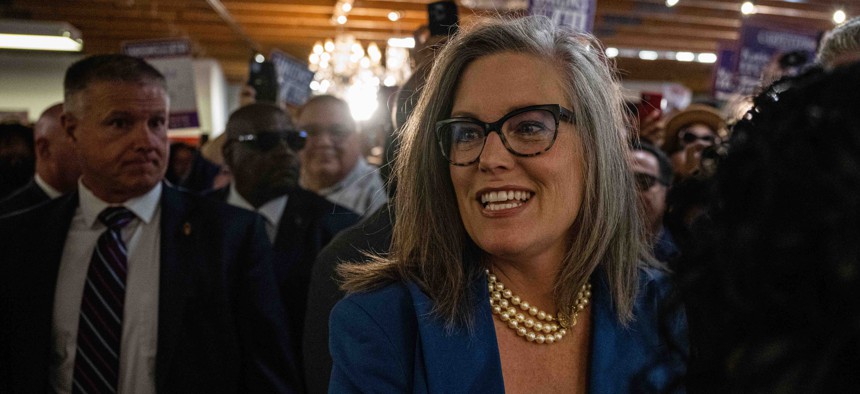With Arizona Win, Democratic Governors Hang Tough in Midterms

Governor-elect of Arizona Katie Hobbs greets supporters while entering a rally to celebrate Hobbs' victory for Governor of Arizona on November 15, 2022 in Phoenix, Arizona. Jon Cherry/Getty Images
Vulnerable incumbents defended their seats, as the party also managed to take control of three governorships held by Republicans, while only ceding one to the GOP.
Democrats notched another win in a gubernatorial race Monday night, as Arizona voters chose a Democrat to lead their state for the first time since Barack Obama became president.
The results cap an unusually productive midterm election at the state level for the Democrats, when the president’s party typically loses power in both Congress and in state capitols. But President Biden’s party largely held on to hotly contested gubernatorial contests. They prevailed in places such as Arizona, Michigan and Pennsylvania where the GOP candidates disputed the 2020 presidential election that Biden won.
There was only one state – Nevada – where a Republican replaced a Democrat. There, Clark County Sheriff Joe Lombardo ousted first-term Gov. Steve Sisolak in a tight race.
In Arizona, Katie Hobbs, currently the secretary of state, narrowly defeated Republican Kari Lake, a former TV reporter endorsed by former President Donald Trump. Hobbs will become the fifth woman governor of Arizona.
“Democracy is worth the wait. Thank you, Arizona. I am so honored and so proud to be your next Governor,” Hobbs wrote on Twitter, after several media organizations declared her the winner based on updated results from elections officials.
While Hobbs will occupy the governor’s ninth-floor office at the Arizona capitol complex, Republicans will retain control of the Legislature.
The Arizona office is the third governorship Democrats took from Republicans this election, with the other Democratic pick-ups in Maryland and Massachusetts.
Michigan Gov. Gretchen Whitmer and Minnesota Gov. Tim Walz, both reelected, will likely have an easier time selling their agenda to lawmakers next year, as Democrats took complete control of the legislatures in both states. Before the elections, Republicans had controlled both chambers in Michigan and the state Senate in Minnesota.
Democrats in Vermont won supermajorities in both legislative chambers, giving them the ability to override vetoes from Republican Gov. Phil Scott. They could also gain control of the Pennsylvania House from Republicans, although the GOP still holds the state Senate there.
For all the shake-ups, though, Republicans still dominate the state political landscape that they have controlled since the 2010 elections. Republicans will control both the executive and legislative branches in 22 states, compared to 17 for Democrats. Party control will be split in 10 states. Alaska used ranked-choice voting for the first time in last week’s elections, so control of the Legislature there has not yet been determined.
“Republicans maintain a strong majority of state legislatures, so they are still in the driver’s seat in state policy,” Tim Storey, the CEO of the National Conference of State Legislatures and a long-time elections expert told reporters last week. “But Democrats clearly dodged a bullet.”
Daniel C. Vock is a senior reporter for Route Fifty based in Washington, D.C.

NEXT STORY: Stopping the Churn: Why Some States Want to Guarantee Medicaid Coverage From Birth to Age 6






